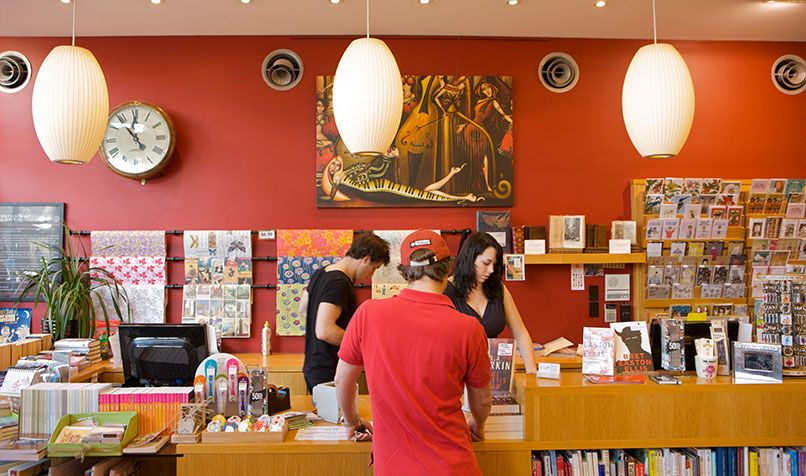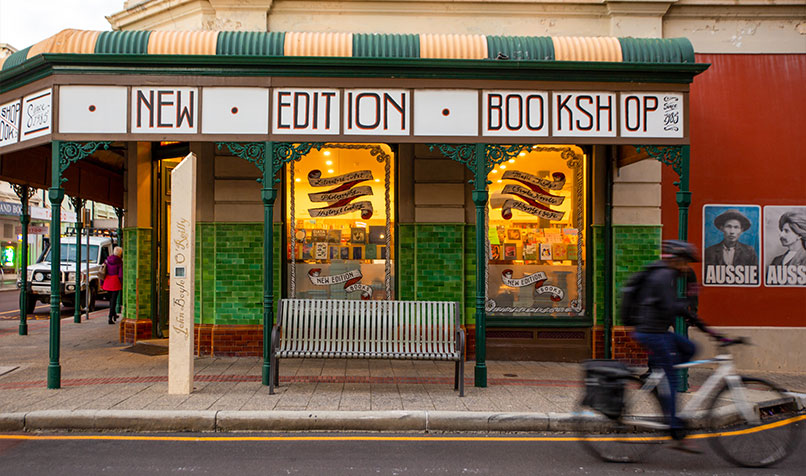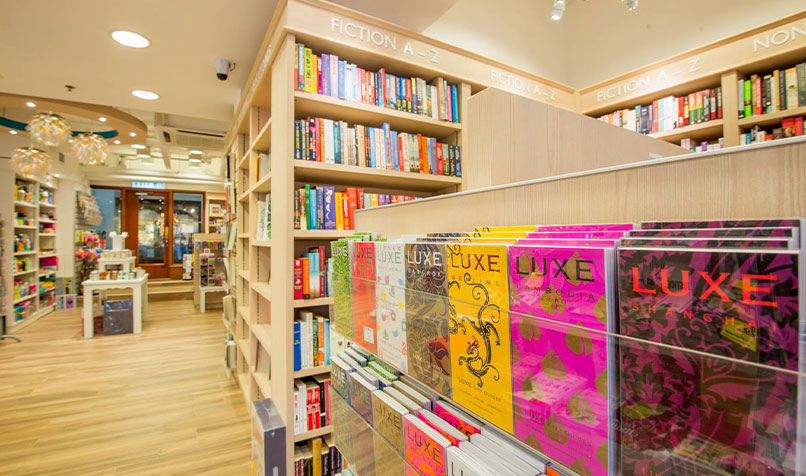Loading component...
At a glance
- Despite numerous predictions of the sector’s downfall, independent bookstores are thriving.
- Independent bookstores have been recognised as having a “halo effect” on a shopping area.
- Competing on service and knowledge rather than location and price, independent bookstores are a vital part of the publishing ecosystem, particularly for launching local authors.
The team at Readings in Melbourne, an independently owned bookstore chain that earned the Australian Book Retailer of the Year award in 2021, has faced several dark moments together. One was the arrival of Amazon in Australia in 2017. Another was the pandemic disruption.
One of the most challenging, says managing director Joe Rubbo, was the announcement in 2003 that American corporate bookstore chain Borders was setting up shop across the road from the flagship Readings store in Carlton.
“We survived, and in fact we thrived,” Rubbo says. “It showed us the importance of community and how much we meant to them. The community took it quite personally and saw it as an affront to them.”
For Borders, the story had a less than happy ending. In 2008, Borders stores in Australia, New Zealand and Singapore were sold to Pacific Equity Partners (PEP), which also owned bookstore chain Angus & Robertson. PEP sold the bookstore businesses on to REDgroup Retail, which went into voluntary administration in 2011.
In 2011, the Borders Group filed for bankruptcy in the US.
With such carnage among the corporate chains, there seemed little hope for independent booksellers. As with all good stories, however, there were plot twists still to come.
The adversary
By the time Amazon created its Australian website, Amazon.com.au, in late 2017, it had long been selling books, ebooks and other products into the Australian market through its existing sales channels.
Given the fate of most record stores, which had perished when competing with digital music streaming businesses, the global rise of Amazon left many doubting the viability of indie bookstores.

It was not the first time that “doomsayers” were vocal about the bookselling market, says Robbie Egan, CEO of BookPeople (formerly the Australian Booksellers Association).
“In the 30 years or so I have been around bookselling, we have always been perceived to be in trouble,” Egan says. “The biggest crisis was REDgroup’s collapse. That was seen as the end of bookshops. I kept explaining to media that it was a private equity failing, not a failing of bookshops.”
In 2011, then-Australian minister for small business Nick Sherry famously said, “I think in five years, other than a few specialist booksellers in capital cities, we will not see a bookstore – they will cease to exist.”
“He was dead wrong,” Egan says.
Secret superpower
Katie Crawford, sales director at publisher Pan Macmillan, says the media had “daggers out” for independent booksellers, because they were seen as vulnerable.
However, Crawford says, they have a secret superpower.
“One of the reasons the good indies thrive is they make a big effort to create a community hub, not just a retail store.
“That includes things like how they present themselves with design and shop fit-out. Readings does it particularly well, but it is not the only one,” Crawford says.
From the Berkelouw Group and Harry Hartog to Gleebooks in Sydney, “they have a vibe that people like to be in, whether they want to buy anything or not”, Crawford says.
Egan agrees that many people who enter independent bookstores have little intention of buying. They simply want to be in the store. Once there, of course, they do purchase.
“There are studies about placemaking by bookshops in communities,” Egan says.
“A successful independent bookshop has a ‘halo effect’. It brings people into a shopping area.
“They will stop at a nearby wine bar, go to a movie cinema and have a meal at a restaurant. They are happy to spend.”
Underdog story

In such light, the success of Readings over corporate giant Borders makes more sense. Purchases are not always driven by price.
In fact, independent bookstores are always under attack on price. Corporate chains such as Big W and Kmart in Australia have long sold significantly discounted books.
“There is a bit of a grotesque pricing issue in books in Australia,” Egan says. “Discount department stores have a loss-leading strategy. They can sell books for less than my members can buy them, but they do not carry the range the independent bookstores carry.”
A 2016 essay by social scientist Ross Honeywill, How Mark Rubbo Killed Borders Books (Mark Rubbo, Joe’s father, purchased Readings in 1976), illustrates the power of passion over price.
On 21 June 2003, the launch day of Harry Potter and the Order of the Phoenix, battle lines between the two stores had been drawn.
"Indies trade on their expertise. When people come into an independent bookstore, they are excited by the service. It is special. It is never transactional but is rather an exchange of information or knowledge."
“This was the first serious test since Borders opened and Rubbo was aware of its significance,” Honeywill wrote.
“As expectations grew, doors opened on either side of Lygon Street in inner city Melbourne. Readings’ in-store events for kids and parents came alive, and in the dizzying theatrics of the morning Rubbo sold a staggering 400 copies before 11am: at full retail price.”
“Over the span of the whole day, more than a thousand customers chose not to cross the street to buy precisely the same book at half-price. While denying it, this was a symbolic blow to Borders. And they just did not get it. ‘Why would someone want to pay full price for a book we will sell them for half-price? We are Borders, for God’s sake. What is going on?’.
“What was going on was loyalty. Real loyalty.”
Moral of the story
Independent bookstores play a vital role in the publishing ecosystem.
While discount department stores (DDS) focus on selling already-successful books at a steep markdown, and major bookstore chains generally promote guaranteed bestsellers, the indies give new authors a leg up into the market.
“Indie bookstores are often the place where an author connects to readers through local event programs,” Crawford says.
“They will often be one of the first channels to support a new author. Indies are also valuable because they are agile.”
Independent bookstores also tend to view reading habits from the customer’s perspective, observing what their customers see and the type of books they seek, she says.
“Indies identify micro trends early, and when it comes to support of authors into non-traditional channels, like schools, often it is the local independent bookseller who has relationships with schools and librarians. They bring huge value.”
9 career advice and business books to read this month
Service promise
Egan adds that service is the most important ingredient in the independent bookstore recipe for success.
Staff are knowledgeable about the products, familiar with individual customers and provide personalised service that simply is not possible online or in discount department stores.
“Indies trade on their expertise,” Egan says. “When people come into an independent bookstore, they are excited by the service. It is special. It is never transactional but is rather an exchange of information or knowledge.”
“If the bookshop is good, consumers do not feel like they are guiltily doing something. It feels like a healthy, rewarding experience.”
Roger Simpson, retail consultant and founder of The Retail Solution, says it is this lesson from independent bookstores he explains to clients.
“My passion is around helping retailers improve service and sales. That is about connecting with the customer and asking questions to discover their needs,” Simpson says.
“It is a service promise. It is about smiling, having a conversation and finding out enough to provide a total solution. It is engaging on both sides, and it is why you do not walk out of a bookstore wondering why you bought a book. Instead, you are excited about reading it.”
In the current retail environment where wages are a major cost, some businesses are cutting back on staff hours.
“It is a real Catch-22,” Simpson says. “If you do not have the people, you will not make the sale.”
Success, Simpson says, often comes from store managers insisting on a service focus such as seeing to customer needs, rather than a task focus such as stacking shelves.
If indie booksellers ever lose their service focus, they will likely find themselves at the conclusion of their business story. Until then, the future is an open book.
Snapshot: A tough market

The number of bookstores in Australia declined by an average of 3.5 per cent per year between 2018–2023, with a total of 1670 businesses in 2024. Bookstore revenue has decreased by 6.3 per cent to A$1.6 billion in the same period.
In comparison, Mainland China has 73,517 bookstore businesses as of 2024, while the US has 43,688, Canada has 1094 and the UK has 1041.
Source: IBISWorld
Indies in Asia

Paul Kenny, marketing, product and data manager at Affirm Press, is a 37-year veteran of the book industry who spent 12 years in Asia as a sales director for Pan Macmillan, then Hachette.
“I was based in Hong Kong but covered Japan to Singapore and Guam to Burma,” he says. “[Mainland] China and the Philippines both came into me via agents, so I was looking after them, too.”
The biggest difference with independent bookstores in Asian territories, compared to Australia, is that they tend to carry out multiple roles, Kenny says.
“They sell trade books to the public, they do educational library supply to public libraries and schools, and textbook supply – things like that,” he says.
“Commercial real estate is incredibly expensive throughout the region.
None of these stores have warehouses, so they have to make the dollar stretch as far as they can. I cannot think of any that do not have at least a dual function, such as a range of gifts.”
Certain bookstores in Asia stand out in Kenny’s mind. “Many stores throughout Asia are beautifully curated and aesthetically stunning,” he says.
Kenny also recommends specific bookstores – both independent and chains – in East and South-East Asia:
- The family-owned Bookazine in Hong Kong
- Fully Booked in Bonifacio High Street, Taguig City in Manila, Philippines, featuring the “Discarded romance” mural
- Kinokuniya Books, Japan
- Tsutaya Books in Daikan-Yama, Japan “Bookstores in Asia are very nimble and cater to their local markets,” he says.
“The independents have survived in Australia and globally because the major chains were in shopping malls and the DDS market offered price.
“The indies realised they could not compete on convenience or price, so they developed an incredible level of service.”

